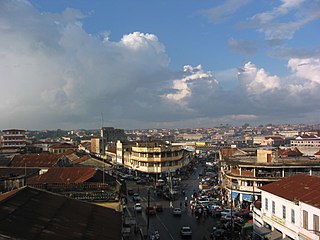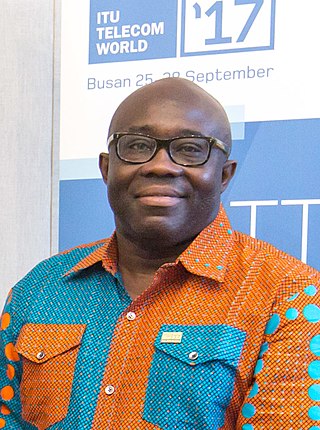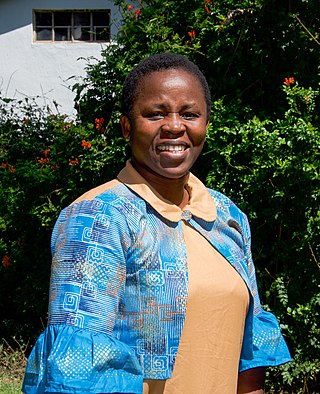The economy of Ghana has a diverse and rich resource base, including the manufacturing and exportation of digital technology goods, automotive and ship construction and exportation, and the exportation of diverse and rich resources such as hydrocarbons and industrial minerals.

Accra is the capital and largest city of Ghana, located on the southern coast at the Gulf of Guinea, which is part of the Atlantic Ocean. As of 2021 census, the Accra Metropolitan District, 20.4 km2 (7.9 sq mi), had a population of 284,124 inhabitants, and the larger Greater Accra Region, 3,245 km2 (1,253 sq mi), had a population of 5,455,692 inhabitants. In common usage, the name "Accra" often refers to the territory of the Accra Metropolitan District as it existed before 2008, when it covered 199.4 km2 (77.0 sq mi). This territory has since been split into 13 local government districts: 12 independent municipal districts and the reduced Accra Metropolitan District (20.4 km2), which is the only district within the capital to be granted city status. This territory of 199.4 km2 contained 1,782,150 inhabitants at the 2021 census, and serves as the capital of Ghana, while the district under the jurisdiction of the Accra Metropolitan Assembly proper (20.4 km2) is distinguished from the rest of the capital as the "City of Accra".

Tamale is the capital city of the Northern Region of Ghana. It is Ghana's third largest city, with a population of 950,000. The city has been ranked as the fastest-growing city in West Africa. It is located 600 km (370 mi) north of Accra.

The Central Region is one of the sixteen administrative regions of Ghana. It is bordered by Ashanti and Eastern regions to the north, Western region to the west, Greater Accra region to the east, and to the south by the Gulf of Guinea. The Central Region is renowned for its many elite high schools and an economy based on an abundance of industrial minerals and tourism. The Central region boasts of many tourist attractions such as castles, forts and beaches dotted along the region's coastline.

The Greater Accra Region has the smallest area of Ghana's 16 administrative regions, occupying a total land surface of 3,245 square kilometres. This is 1.4 per cent of the total land area of Ghana. It is the most populated region, with a population of 5,455,692 in 2021, accounting for 17.7 per cent of Ghana's total population.

The Accra Metropolitan District is one of the 254 Metropolitan, Municipal and Districts in Ghana, and among the 26 such districts in the Greater Accra Region with a population of 284,124 as of 2021. As of March 2018, it spans an area of approximately 60 km2 (23 sq mi) and encompasses the Ablekuma South, Ashiedu Keteke, and Okaikoi South sub-metropolitan district councils.

Kumasi Metropolitan Assembly is one of the 261 Metropolitan, Municipal and District Assemblies (MMDAs) in Ghana. It forms part of the forty-three districts in Ashanti Region, Ghana with Kumasi being its administrative capital. The metropolis is located in the central part of Ashanti Region and has Kumasi as its capital city.With a projected population of over two million and an annual growth rate of about 5.4%, it is a rapidly expanding metropolis. The Metropolis is about 254 kilometers long, with a centrally located commercial area and a largely circular physical structure.The fast rate of urbanization is confirmed by estimates that 48%, 46%, and 60% of the Metropolis are rural, peri-urban, and urban, respectively.

Located directly east of the Korle Lagoon, Jamestown and Usshertown are the oldest districts of Accra, Ghana and emerged as communities around the 17th century British James Fort and Dutch Ussher Fort on the Gulf of Guinea coast. These districts were developed at the end of the 19th century, and following the rapid growth of the city during the 20th century, they became areas of a dense mixture of commercial and residential use.

Madina is a suburb of Accra and in the La Nkwantanang Madina Municipal District, a district in the Greater Accra Region of southeastern Ghana. Madina is next to the University of Ghana and houses the Institute of Local Government. Madina is the twelfth most populous settlement in Ghana, in terms of population, with a population of 137,162 people. History has it that Madina was established by people from different ethnic backgrounds and some foreigners led by Alhaji Seidu Kardo. Madina is contained in the Madina electoral constituency of the republic of Ghana. It shares borders with Adentan Municipal on the west, the Accra Metropolitan Assembly to the South and the Akwapim South District. to the north.

Hanna Serwaa Tetteh is a Ghanaian barrister and politician. She served in the cabinet of Ghana as Minister for Trade and Industry from 2009 to 2013 and Minister for Foreign Affairs from 2013 to 2017. She was also the Member of Parliament for the Awutu-Senya West constituency. She currently serves as the UN Secretary General's Special Envoy for the Horn of Africa.

Ga West Municipal District is one of the twenty-nine districts in Greater Accra Region, Ghana. Originally it was formerly part of the then-larger Ga District in 1988, until the eastern part of the district was split off to create Ga East District in 2004; thus the remaining part has been renamed as Ga West District. Later, the western part of the district was split off to create the first Ga South Municipal District on 29 February 2008, with Weija as its capital town; while Ga West was later elevated to municipal district assembly status during that same year to become Ga West Municipal District. However on 15 March 2018, the eastern part of the district has split off to create Ga North Municipal District, thus the remaining part has been retained as Ga West Municipal District. The municipality is located in the western part of Greater Accra Region and has Amasaman as its capital town.
Awoshie is a town located in Ga central and Ablekuma North Municipal Districts of the Greater Accra Region of Ghana.
Mallam is a town in the Greater Accra Region of Ghana. It is located on the main Kaneshie - Winneba Highway, a peri-urban town in the Weija-Gbawe Municipal Assembly of the Greater Accra region of Ghana. The town, in recent years, has seen a lot of slow but steady developments under different governments in the country. Mallam experiences a five-month dry season lasting from November through March. During the dry season, the northeast trade winds are prominent. The dry season is followed by a seven-month rainy season that lasts from April through October. During this rainy season, the southwest monsoon winds are most common. The rainy season is usually characterized by flooding, low crop yield, and financial strain on the locals of the area.

George Nenyi Kojo Andah is a Ghanaian politician and the former Member of Parliament of the Awutu Senya West Constituency in the Central Region of Ghana. He is a member of the New Patriotic Party and the Deputy Minister for communications in Ghana.

Awutu Senya East Municipal District is one of the twenty-two districts in Central Region, Ghana. Originally it was formerly part of the then-larger Awutu Senya District on 29 February 2008, until the eastern part of the district was split off to create Awutu Senya East District on 28 June 2012, which it was later elevated to municipal district assembly status on 15 March 2018 to become Awutu Senya East Municipal District; thus the remaining part has been renamed as Awutu Senya West District. The municipality is located in the southeast part of Central Region and has Kasoa as its capital town.

Awutu Senya West District is one of the twenty-two districts in Central Region, Ghana. Originally it was formerly part of the then-larger Awutu Senya District on 29 February 2008, until the eastern part of the district was split off to create Awutu Senya East District on 28 June 2012 ; thus the remaining part has been renamed as Awutu Senya West District. The district assembly is located in the southeast part of Central Region and has Awutu Breku as its capital town.
Harona Esseku was a Ghanaian politician who served as Ghana's Minister for Transport and Communications from 1969 to 1971. He was approved as a cabinet minister at an age of thirty-five making him the youngest cabinet member of the Second Republic. In the Fourth Republic, he became a founding member of the New Patriotic Party and was National Chairman of the party from 2001 to 2005.
Awubia Festival is an annual festival celebrated by the chiefs and people of Awutu Traditional Area in Awutu Bereku in the Central Region of Ghana. The town is in the Awutu Senya district. It is usually celebrated in the month of August through to September. The festival is also known as Awutu Awubia Festival.

Tapiwa Uchizi Nyasulu, is a Malawian diplomat, social scientist, women's rights activist, anti-corruption activist and academic. Tapiwa currently leads on Women and Gender Policy and Development at the African Union. Before joining the African Union, she was Regional Advisor for Southern Africa at Transparency International, where she managed and implemented the Africa Regional Anti-Corruption Programme.

The Greater Accra Metropolitan Area(GAMA) is a metropolitan region centered in Ghana's capital Accra. With around five million inhabitants, the metropolitan area is one of the 90 largest agglomerations in the world. The GAMA is largely continuous, but not identical with the Greater Accra Region.
















